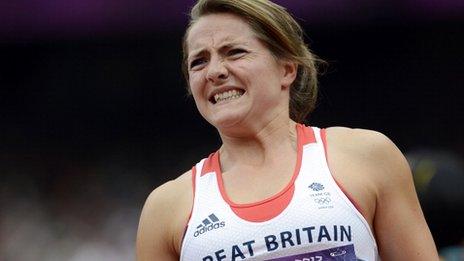Goldie Sayers: My London 2012 'nightmare' and the long road back
- Published
Goldie Sayers back on track after injury
It is your home Olympics, the pinnacle of your sporting career, the definition of a once-in-a-lifetime moment.
A crowd of 80,000 has roared you into the stadium. You have been in such prime form that in your last competition, you beat the world record holder by three metres. And here you are, ready to strike for the summit, suddenly unable to perform your most routine yet essential physical task.
"It was like those nightmares where you're being chased, and you can't run," says Goldie Sayers, nine times British javelin champion, two years on from a London 2012 experience that came close to wrecking her.
"My warm-up had seemed to go fine, and I remember my run-up was perfect. But I was putting as much effort into each throw as I could, and it was landing at 48 metres. I can pretty much do that standing still.
"I couldn't work out why this javelin was sliding out of my hand. I was just baffled. I was lumping it as hard as I could, and it was going nowhere.
"But there was nothing attaching my forearm to my upper arm. I'd just snapped my elbow and hadn't realised it."
Lowdown on Sayers | |
|---|---|
Age | 31 |
Event | Javelin |
Honours | Ten-time British champion |
Olympic record | 2004 - 9th; 2008 - 4th; 2012 - injured in qualifying |
Personal best | 66.17m (British record) |
Also | Former national under-12 table-tennis champion |
Sayers was not the only British athlete whose 2012 Olympics, far from being the defining moment of their career, became the worst. Injury also scuppered her fellow medal contenders Phillips Idowu and Dai Greene. It is the side of the Games that gets lost amongst the fairytales: for every winner of sport's ultimate golden ticket, many more leave wondering why form or fortune abandoned them at the most critical hour of all.
Neither is Sayers one for self-pity, for equating sporting misfortune with the more fundamental calamities that life can throw up. But hers is certainly one of the crueller tales from that wonderful fortnight two summers ago. There is the physical pain of an arm mangled and two years lost to multiple surgeries and false starts. And there is the mental ache: why me, why now, why again?
Three weeks before the Olympics, at the Diamond League meet at Crystal Palace, Sayers had comprehensively beaten all of her global rivals, setting a new British record of 66.17m to confirm what all her gym tests and drills had indicated: she was in the shape of her life.
"I had the best three rounds I've ever produced," she says. "I remember saying to my coach, 'I'll have one more throw, and then can it and save it for London.'"
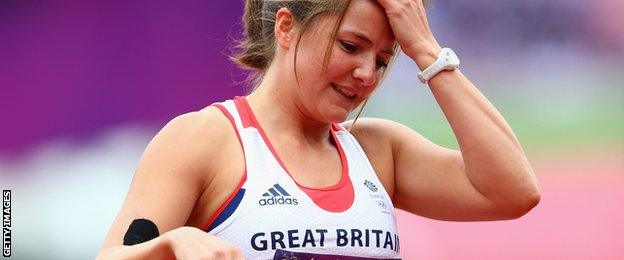
In 15 years of throwing javelin, Sayers had never before hurt her elbow. On that fourth throw, victory already secured, she did.
By the evening she could not raise her hand to her face. A 30th birthday spent in an MRI scanner revealed a partial tear in her ulnar collateral ligament, external - bad, but not the end. A frantic fortnight of massage, acupuncture and painkillers got her into the Olympic Stadium.
And then, on her first throw in qualifying, the point of no return: arm back, tendon snapped in two. There was no pain, not until the injections wore off. There were also no tears, at least not while she thought the cameras were rolling. And then both hit at once.
"I lost it, and I lost it for a long time," she says, sitting on the infield of the track at Lee Valley, a few miles north of Stratford's Olympic Stadium.
"Before then I'd never really believed in luck. That sometimes something happens, and there's nothing you can do about it."
Sayers recalls watching from under the Olympic flame as training partner Greg Rutherford won gold in the long jump. "It was amazing, seeing friends and team-mates do so well," she says. "And I thought the support was so incredible we were all going to win medals."
She smiles. "I've learned quite a lot through this whole process. But on the day it was just… horrific.
Sayers recalls costly javelin throw
"It's difficult to rationalise, except by reasoning, this happens in lots of different areas in life. You get hit by a car. Sometimes it's not under your control.
"My only regret is not sitting down at Crystal Palace after three rounds. But when have I ever done that?"
So far, so ill-fated. Yet the journey back would prove equally treacherous.
Within a week of the closing ceremony, Sayers had an operation to tie the two ends of the ruptured ligament together, the surgeon confident she would be throwing again by January 2013. Instead, come the New Year, there was only swelling and pain.
A scan showed a metal screw was sticking out - only by half a centimetre, but enough to have worn through the bone. The solution: another operation, this time to remove the screw and fill in the bone.
Except that, when the arm was opened up and the ligament was tested under general anaesthetic, it was found to be already coming apart.
"I remember waking up, and the doctor was very direct, and he's not a very direct person," she says. "He looked at me and said, 'The ligament's not strong enough. You need a reconstruction.'
"I could have thought, 'Is there any point? I'm clearly not going to throw a javelin again.' But I was thinking too about the rest of my life.
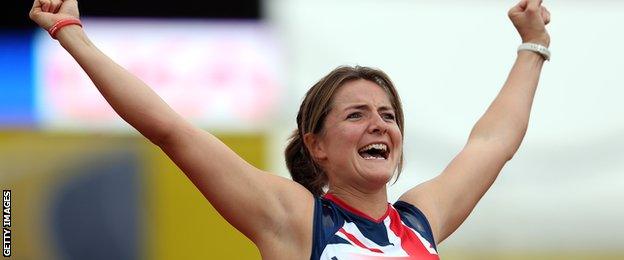
"I wanted to be able to throw a ball, to play tennis. I wanted an elbow I could use. I just love to throw stuff.
"Within two hours I was researching everything I could about the ligament. That was how I dealt with it. I'm a bit of a problem solver. I'm not overly emotional, which isn't always a good thing, but I'm always thinking, 'what can I do next?'
"I was told it had been opened up twice, so the chances of a successful reconstruction were slim. So I thought, 'right, I need the best elbow surgeon in the world.'"
Advice from England cricketer Graeme Swann and American decathlete Trey Hardee narrowed the field to two doctors in the US. Long interviews over FaceTime followed, which led to a 70-year-old surgeon in West Florida named James Andrews. On his client list were American footballer Tom Brady, golf legend Jack Nicklaus and basketball great Michael Jordan.
"I'd read all his research and all his papers," says Sayers. "But when he first walked in the room he looked like Father Christmas and sounded like Forrest Gump. I thought, 'wow, have I got the right man?'"
Andrews opened up her left wrist, removed the palmaris tendon, sliced open her right elbow, drilled holes in the ulna and humerus bones and wove the harvested tendon into place. All of which graphic detail makes it somewhat surprising to learn that Sayers was in the gym the next day, mother Liz alongside her to do things like open doors and tie shoelaces.
"In my family. the women are pretty strong. We just get on with it. Do what you can with what you've got.
"But when you're not able to do it at all, you do think about it differently. You definitely take it 10 times less for granted, and I wasn't someone who took it for granted in the first place.
London Grand Prix: Sayers breaks GB javelin record
"When I was off that summer, having competed since I was 13, I made sure I went to music festivals, drank more than I ordinarily do. I was standing at the V Festival watching the Kings of Leon, and desperately trying to refresh the browser on my phone so I could see the results from the javelin at the World Championships. Thinking I would so rather be there. "
Finally, 23 months on from London, despite also having her funding cut by British Athletics before a successful appeal, Sayers is ready to compete again.
This weekend she will be at the British Championships in Birmingham., external Beyond that lies the Commonwealth Games in Glasgow, and the European Championships in Zurich. Every single throw will be relished.
"I've never once had pain in that elbow ligament. And pain is what triggers fear, because that's what fear is, really. So it's not been in my mind. But you will treat every competition as your last, because I could have had my last in a British vest.
"Sport can be really cruel. But having had those low points does make the highs much higher. It did make me think, 'if I'd have been someone who's been successful from year dot, would that have been as much fun?'"
Beyond Glasgow lies Rio. After the misery of London, after missing out on a medal in Beijing by just 38 centimetres, is she already thinking of what might happen at her fourth Olympics?
"You always do. We're already halfway through this Olympic cycle. A lot of people have done well in throws at that age."
A year on from that, in the summer of 2017, athletics will return to London's Olympic Stadium once again.
When those World Championships begin, Sayers will be 35. Too old? Too late? A little precedent: when Jan Zelezny,, external the greatest javelin thrower of them all, won his last world title, he was also 35. When Germany's Steffi Nerius, external won world gold in Berlin's Olympiastadion in 2009, she was 37.
"I have thought about that," smiles Sayers. "I remember thinking about it, walking off at 2012. Thinking, 'right, I can't retire until I've walked off this track having won the thing. Or at least medalled…' And then that's it. I can put javelin to bed, and go and get a proper job."
- Published26 June 2014
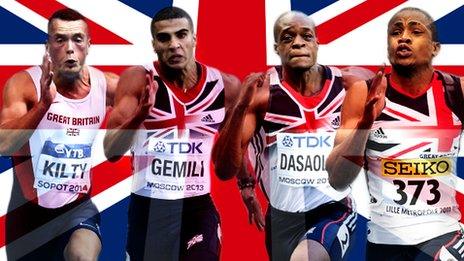
- Published27 June 2014
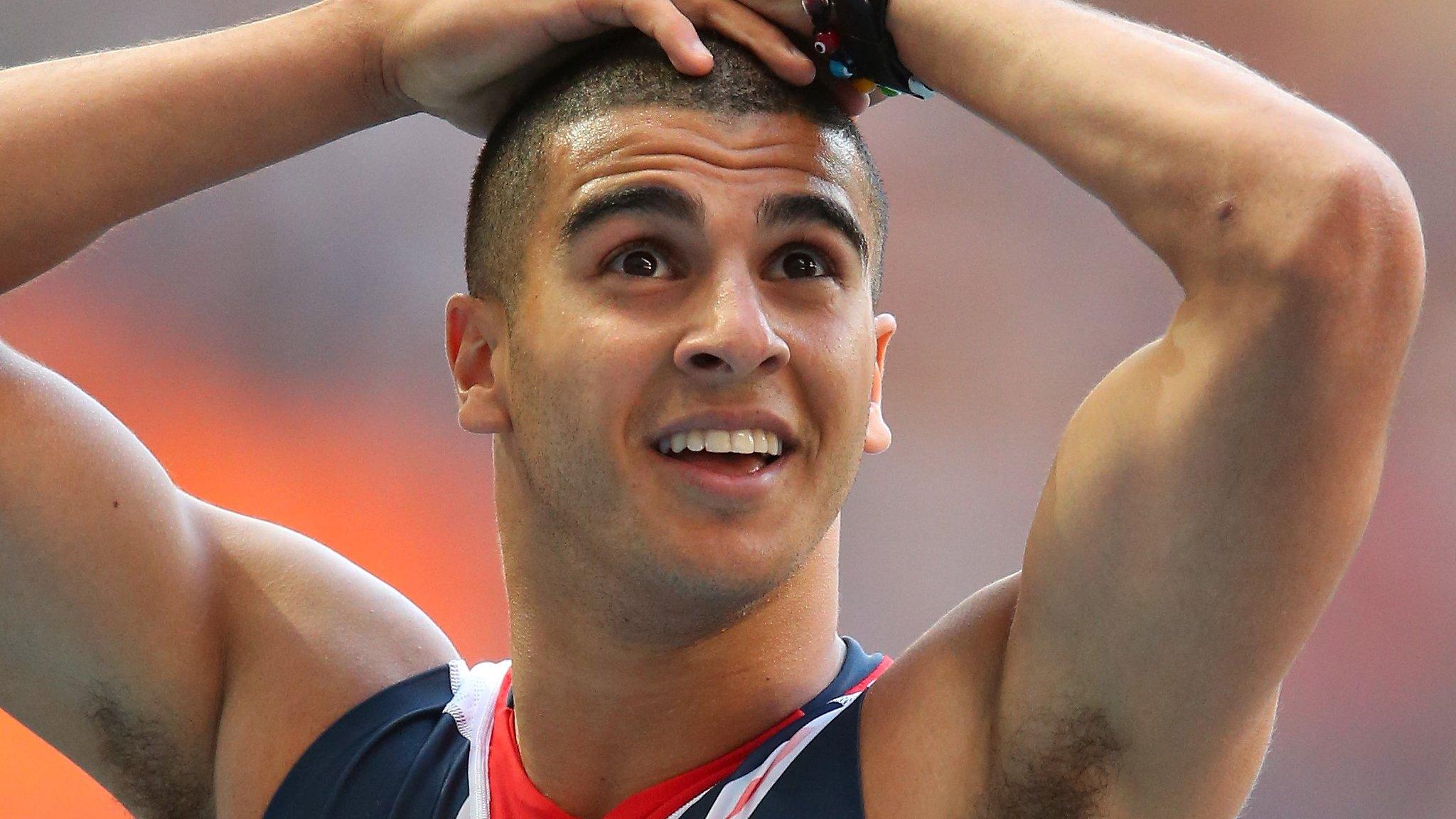
- Published6 November 2013
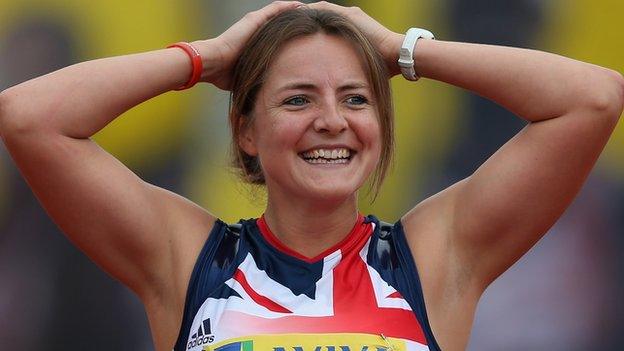
- Published7 March 2013
